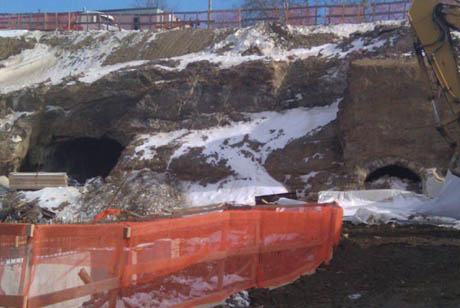
IMAGE: Above-ground entrances to the Bronx beer caves. Photo by blogger Ed García Conde.
On Christmas Day, the New York Times broke the exciting news that a construction project in the South Bronx had uncovered several abandoned beer caves. In fact, an arched entrance to the largest one is currently visible at the corner of St. Ann’s Avenue and 156th Street. According to the Times:
The Joy Construction Corporation, a developer building housing on the site, uncovered the caves in May, soon after construction began. Work was replaced with wild speculation: Were the caves part of the Underground Railroad? Secret fallout shelters?
It took some research to confirm that an improbable answer was the right one: here in the South Bronx, less than two miles from Yankee Stadium, a network of old beer caves that had stood silent for generations.
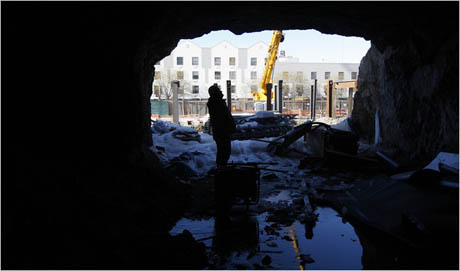
IMAGE: Inside the Ebling Caves. Photo by Ruth Fremson for the New York Times.
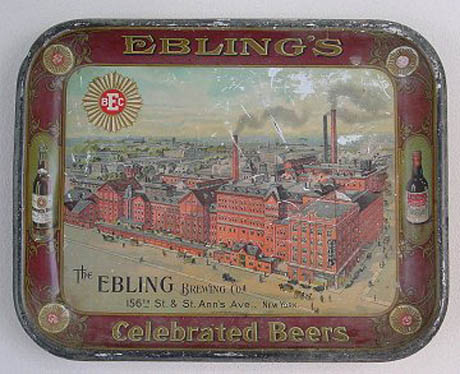
IMAGE: The Ebling Brewing Company, South Bronx, via Flickr user The Earl of Steinway.
Apparently, the caves were originally built by the Ebling Brewing Company to age their lager. The company, which was founded in 1868, is long gone: the Times reported that Ebling was “hit hard by Prohibition,” and “limped along until the 1940s, when it finally closed.” After that, “the Ebling buildings were eventually razed and replaced with a crude parking lot. The caves, more than 20 feet wide and 100 feet deep in some places, were covered, forgotten by nearly everyone.”
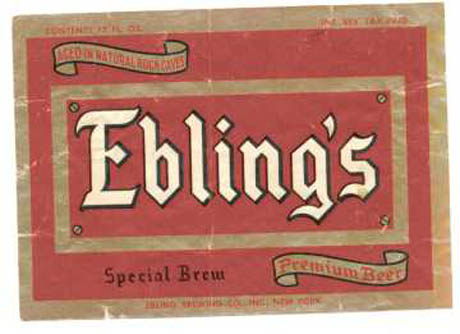
IMAGE: Ebling’s Special Brew label, complete with the promise “Aged in Natural Rock Caves,” via.
Although Ebling labels claimed that their beer was “aged in natural rock caves,” their caverns were actually carefully constructed – some even had electricity. Now, however, the Times reports that the cave floors “are covered with rubble and dirt. Icicles glisten in the shards of light, rusty rods of mysterious purpose dangle from the ceiling, a wall of old bricks holds back the earth.”
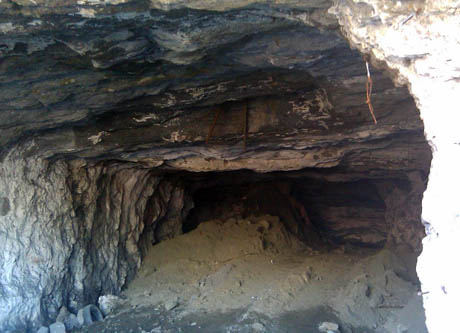
IMAGE: Looking inside the Ebling Caves. Photo by blogger Ed García Conde.
Aging bottled beers in caves (or cellars) is actually a traditional Belgian brewing technique, which was more common in America before the advent of modern refrigeration. According to Ommegang Brewery, who claim to be the only company still cave-aging their Three Philosophers ale in the United States:
There is no doubt that these dark, silent, subterranean ‘cathedrals’ are the ideal surroundings for secondary fermentation and maturation of wines and beers. It is further known that cold constant temperature between 50 and 55 degrees leads to great complexity.
Ommegang ages its beer in natural limestone caverns in upstate New York, where the temperature is a constant 52º, while the manmade Ebling caves apparently rest at a slightly warmer 58º. Nonetheless, Ebling’s bottle maturation would presumably also have led to a “second fermentation,” which beer experts concur “produces a notable increase in carbonation, and a softer mouthfeel,” as well as the previously mentioned increase in complexity.
In fact, according to Allagash (another Belgian-style brewery based in the northeast U.S.), this technique, which is also known as the méthode champenoise, “leaves a small amount of yeast in the bottle, creating what is known as a ‘living’ beer. As a result, these styles have a greatly enhanced shelf life and some styles will age exceptionally, much like a fine wine.”
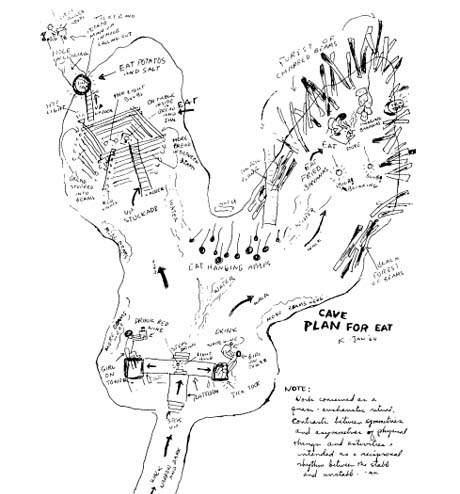
IMAGE: Allan Kaprow’s sketch for Eat, via.
Interestingly, Ebling’s cave have already experienced an earlier rediscovery. Allan Kaprow, an American performance artist, created his final “Environment” in the caves during two weekends in January 1964. The interactive installation, called Eat, could only be visited for one hour at a time, by reservation, according to a contemporary description by Michael Kirby in the Tulane Drama Review that is worth quoting at length:
After entering an old building that fronted low cliffs, the visitor walked through several corridors and doorways and finally came to the Environment. The rock from which the caves were carved had been somewhat incompletely covered with white paint – the place had once been used by Ebling Brewery – and age and seeping water had created a sense of decay. Black charred wooden beams stood propped against the walls in several places. Here and there water collected in depressions in the floor and trickled in rivulets through the dirt.
As they explored the installation, visitors encountered apples hanging “on rough strings” from the ceiling, to which they could help themselves if they wished. Or, Michael Kirby noted, “if [the visitor] was not very hungry, he could merely take a bite from it and leave it dangling.”
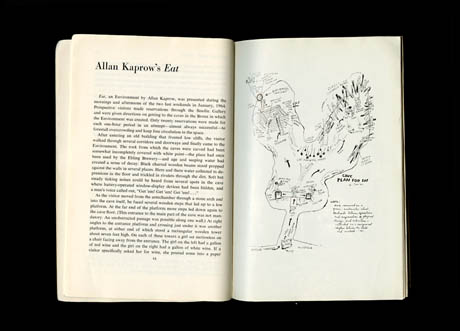
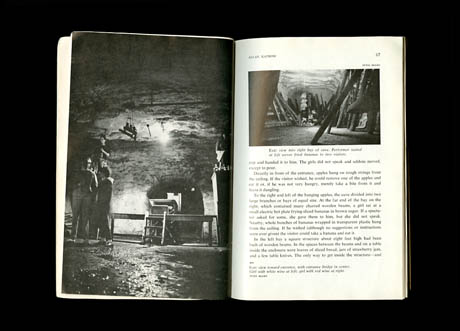
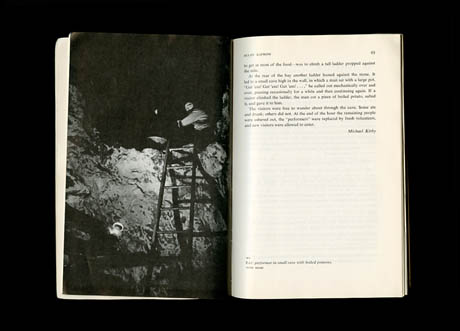
IMAGE: Spreads from Michael Kirby’s article about Allan Kaprow’s Eat in the Tulane Drama Review (Volume 10, Number 2, Winter, 1965), via the Design blog at the Walker Art Center.
Further inside the cave, “a girl sat at a small electric hot plate frying sliced bananas in brown sugar. If a spectator asked for some, she gave them to him, but she did not speak.” After encounters with similarly mute girls who would pour wine if asked, as well as a table laden with strawberry jam and sliced bread, visitors would reach the rear of the cave, where “a man sat with a large pot.”
‘Get ’em! Get ’em! Get ’em! …,’ he called out mechanically over and over, pausing occasionally for a while and then continuing again. If a visitor climbed the ladder, the man cut a piece of boiled potato, salted it, and gave it to him.
The visitors were free to wander through the cave. Some ate and drank; others did not.
Sadly, the Ebling beer caves are being filled-in to support the foundations of the new buildings. According to the New York Times, four caverns have already been sealed, and the remaining three “will be closed off in the coming months.” The developer has, however, sold “truckloads of rock” from the caves “to a swimming pool company in Long Island that will use it in its landscaping projects.”
This seems a fittingly surreal postscript to Kaprow’s installation, if nothing else. Nonetheless, it’s disappointing that the caves cannot be re-used – whether to grow mushrooms, store cheese, or even age ultra-local Bronx moonshine.

